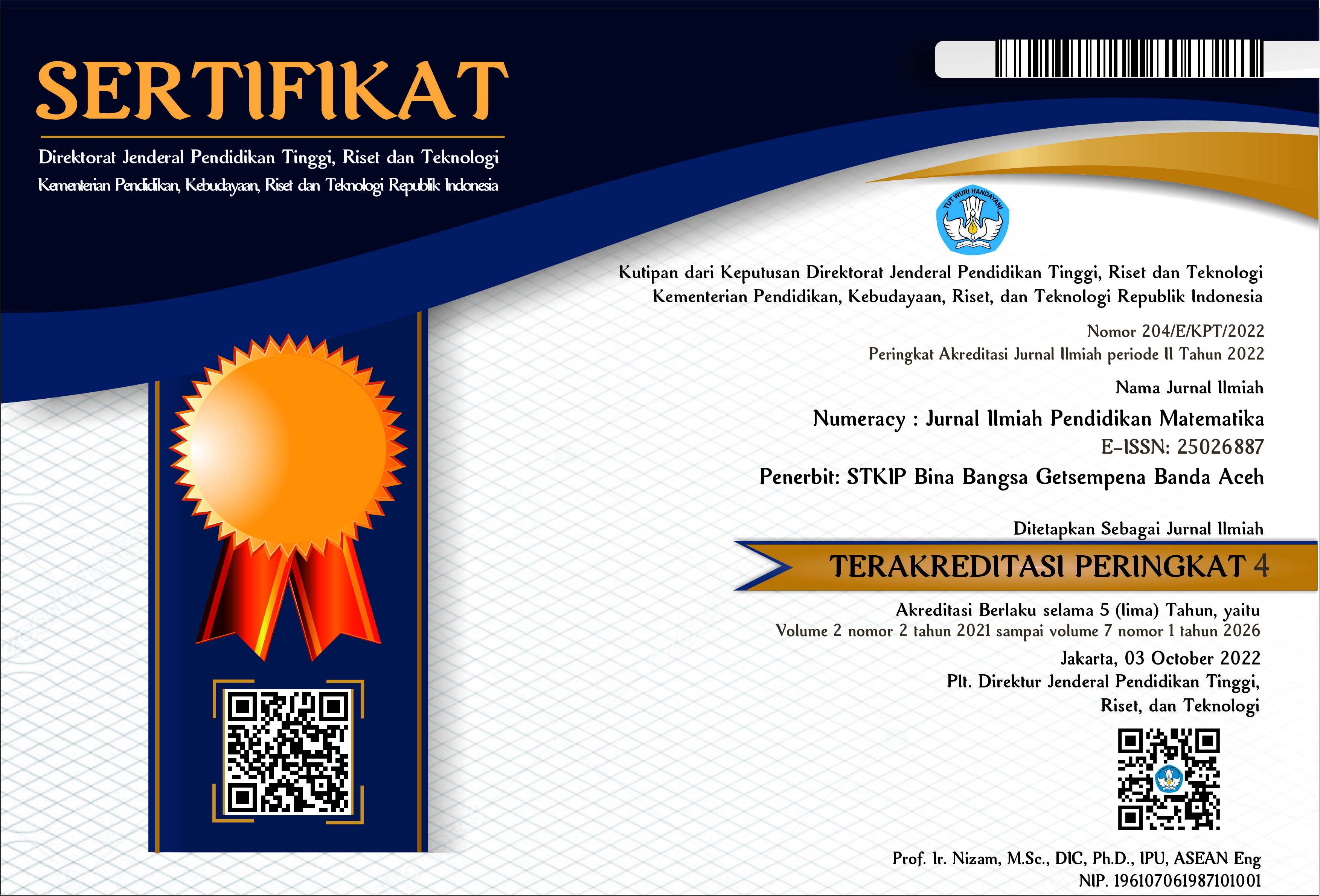MENILIK KONSEP KEMAMPUAN BERPIKIR TINGKAT TINGGI (HIGHER ORDER THINKING SKILLS) DALAM PEMBELAJARAN MATEMATIKA
Abstract
Higher Order Thinking Skills (HOTS) are a demand of the 2013 curriculum in Indonesia. Schools’ commitment to higher level thinking is largely rhetorical, while curriculum development is often ineffective. This paper aims to discuss critical thinking skills, higher-order thinking skills (HOTS), teachers’ effort to teach and enhance student’s higher level thinking, levels of students’ HOTS according to Bloom and Marzano's Taxonomy, and the relationship between HOTS and mathematical literacy. This paper is expected to provide information for mathematics teachers and researchers in order to enhance the quality of mathematics education that has an impact on the development of human resources in Indonesia.
Abstrak
Kemampuan berpikir tingkat tinggi atau dikenal juga dengan Higher Order Thinking Skills (HOTS) merupakan tuntutan Kurikulum 2013. Komitmen sekolah terhadap pemikiran tingkat tinggi sebagian besar bersifat retoris, sementara pengembangan kurikulum seringkali tidak efektif. Makalah ini bertujuan untuk mendiskusikan ketrampilan berpikir kritis, ketrampilan berpikir tingkat tinggi (Higher Order Thinking Skills -HOTS), langkah guru membelajarkan dan mengasah HOTS siswa, Level HOTS siswa menurut Taksonomi Bloom dan Marzano, dan kaitan antara HOTS dan literasi matematika. Makalah ini diharapkan dapat memberikan masukan bagi pendidik dan peneliti matematika agar sehingga dapat memberikan masukan atau sumbangan untuk peningkatan kualitas pendidikan matematika yang berdampak pada perkembangan sumber daya manusia di Indonesia.
Kata Kunci: Ketrampilan Berpikir Kritis, Keterampilan Berpikir Tingkat Tinggi, HOTS, Taksonomi Bloom, Literasi Matematika
References
Siswono, TYE. 2018. Pembelajaran Matematika Berbasis Pengajuan dan Pemecahan Masalah. Bandung : Remaja Rosdakarya. (hal.5-12)
Beghetto, R. A., & Kaufman, J. C. (2007). Toward a Broader Conception of Creativity : A Case for “ mini-c ” Creativity. Psychology of Aesthetics, Creativity, and the Arts, 1(2), 73–79. https://doi.org/10.1037/1931-3896.1.2.73
Ennis, R. H. (1985). A Logical Basis for Measuring Critical Thinking Skills. In Educational Leadership (p. 43).
Gradini, E., Firmansyah B, & Noviani, J. (2018). Menakar Kemampuan Berpikir Tingkat Tinggi Calon Guru Matematika Melalui Level Hots Marzano. Eduma: Mathematics Teaching and Learning, 7(2), 41–48.
Hmelo, C. E., & Ferrari, M. (1997). The Problem-Based Learning Tutorial : Cultivating Higher Order Thinking Skills. Journal for the Education of the Gifted, 20(4), 401–422.
Stanley, D. I. (2015). Ausubel ’ s Learning Theory : An Approach To Teaching Higher useful. The High School Journal, 82(1), 35–42. Retrieved from http://www.jstor.org/stable/40364708
Widana, I. wayan, Adi, S., Herdiyanto, Abdi, J., Marsito, & Istiqomah. (2019). Modul Penyusunan Soal HOTS Matematika. Retrieved from www.psma.kemdikbud.go.id
Bransford, J. D., Brown, A. L., & Cocking, R. R. (Eds.). (2000). How people learn: Brain, mind, experience, and school. Washington, DC: National Research Council, National Academy Press.
Adey, P. (1999). The science of thinking, and science for thinking: A description of Cognitive Acceleration through Science Education (CASE) [INNODATA Monographs–2]. Geneva, Switzerland: International. Bureau of Education, UNESCO.
Adey, P., & Shayer, M. J. (1994). Really raising standards. London: Routledge.
Brown, A. L., & Campione, J. C. (2002). Communities of learning and thinking, or a context by any other name. Contemporary issues in teaching and learning, 120-126.
Burden,R.,&Williams,M.(1998). Thinking throughthe curriculum.LondonandNewYork: Routledge. Carmichael, J. W. (1981). Project SOAR (Stress on Analytical Reasoning) instructor’s manual. New Orleans: Xavier University of Louisiana.
Chance, P. (1986). Thinking in the classroom:Asurveyofprograms.NewYork:Teachers CollegePress.
De Bono, E. (1985). The Cort thinking program. In J.W. Segal, S. F. Chipman,&R. Glaser (Eds.), Thinkingand learning skills (Vol. 1, pp. 389–416). Hillsdale, NJ: Lawrence Erlbaum Associates, Inc.
Feuerstein, R., Rand, Y., Hoffman, M. B., & Miller, R. (1980). Instrumental enrichment and intervention program for cognitive modifiabilty. Baltimore: University Park Press.
Feurstein, R., Rand,Y.,&Rynders, J. E. (1988). Don’t accept me as I am.NewYork and London: Plenum.
Greeno, J. G., & Goldman, S. V. (Eds.). (2013). Thinking practices in mathematics and science learning. Routledge.
Lipman,M.(1985). Thinking skills fostered by philosophy for children. In J.W. Segal, S. F. Chipman,&R.
Glaser(Eds.),Thinkingandlearningskills(Vol. 1). Hillsdale,NJ:LawrenceErlbaumAssociates, Inc.
Marzano, R. J., Brandt, R. S., Hughes, C. S., Jones, F., Presseisen, B. Z., Rankin, S. C., & Suhor, C. (1988). Dimensions of thinking: A framework for curriculum and instruction. Alexandria, VA: Association for Supervision and Curriculum Development (ASCD).
Nickerson, R., Perkins, D., & Smith, E. (1985). The teaching of thinking. Hillsdale, NJ: Lawrence Erlbaum Associates, Inc.
Perkins,D.N.(1992).Smartschools—Fromtrainingmemoriesto trainingminds.NewYork: Free Press.
Perkins, D. N.,&Grotzer, T.A. (1997). Teaching intelligence. American Psychologist, 52, 1125–1133.
Resnick, L. (1987). Education and learning to think. Washington, DC: National Academy Press.
Resnick, L. B., & Resnick, D. P. (1992). Assessing the thinking curriculum: New tools for educational reform. In B. R. Gifford&M. C. O’Connor (Eds.), Changing assessments: Alternative views of aptitude, achievement and instruction (pp. 37–75). Boston: Kluwer.
Schoenfeld, A. (1992). Learning to think mathematically. InD.A. Grouws (Ed.), Handbook of research in mathematics teaching and learning (pp. 334–370). New York: Macmillan.
Tishman, S., Perkins, D., & Jay, E. (1995). The thinking classroom. Boston: Allyn & Bacon.
Paul, R. W., & Binker, A. J. A. (1990). Critical thinking: What every person needs to survive in a rapidly changing world. Center for Critical Thinking and Moral Critique, Sonoma State University, Rohnert Park, CA 94928.



















